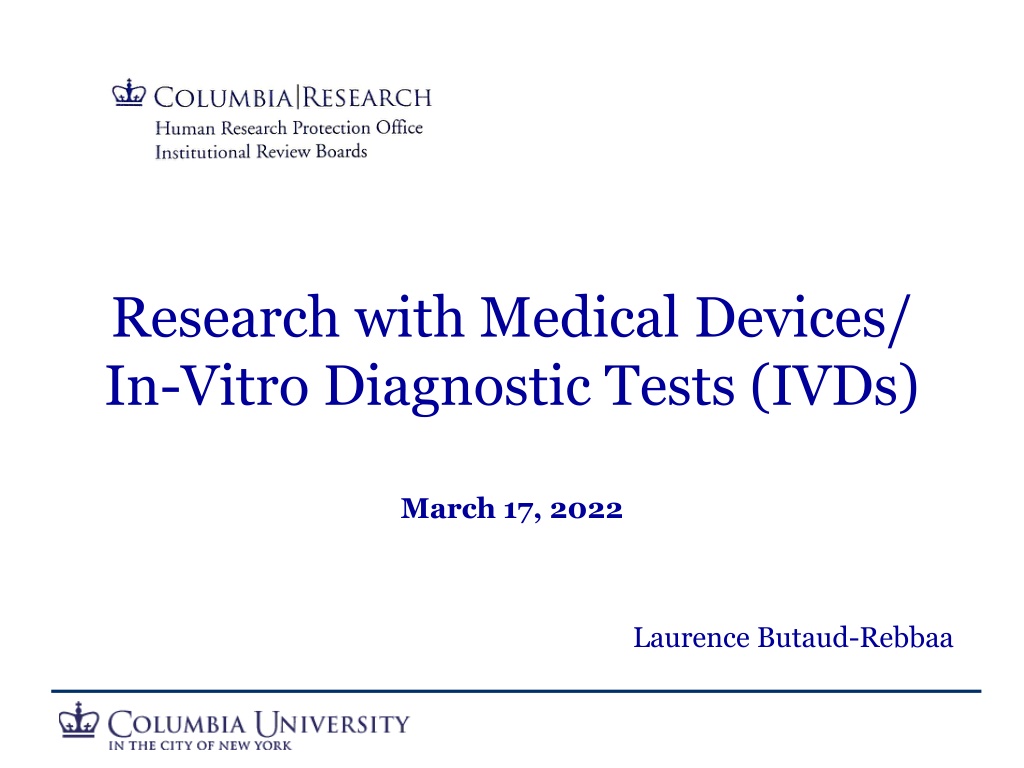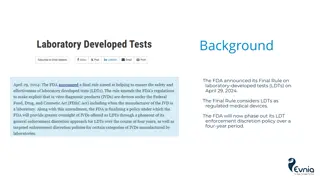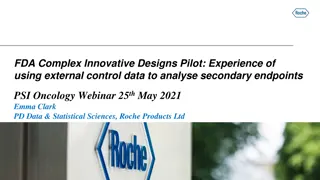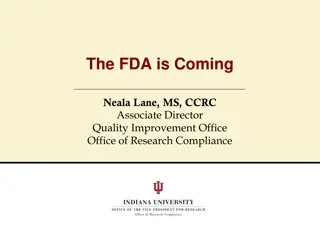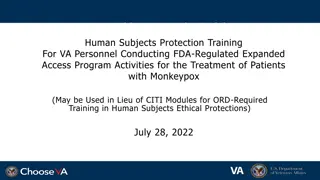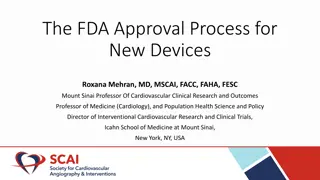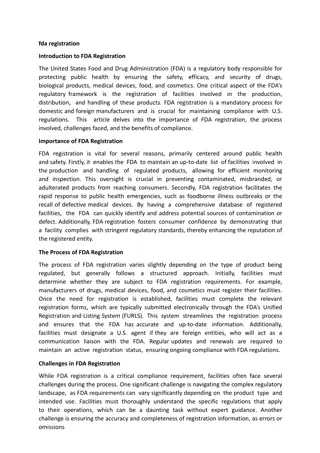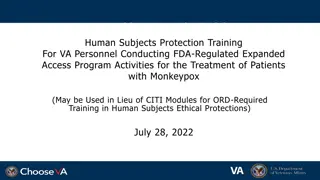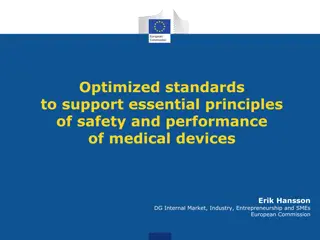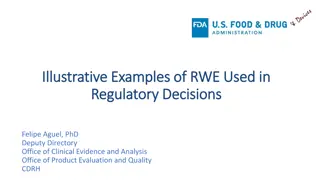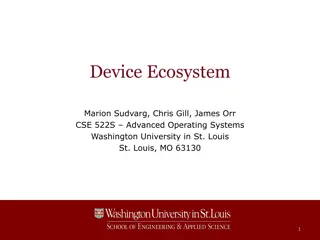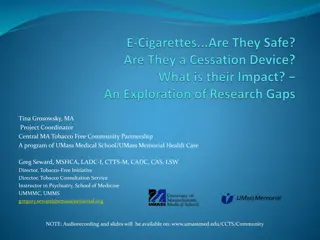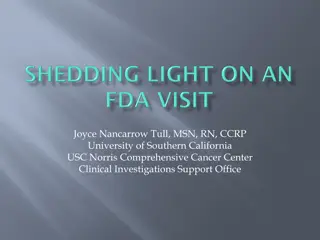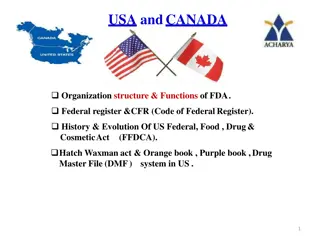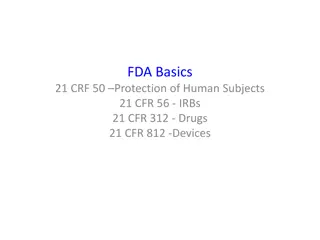Understanding FDA Regulations and Medical Device Classification
The Food and Drug Administration (FDA) plays a crucial role in regulating research, manufacturing, marketing, and distribution of medical devices. Medical devices are classified based on risk and intended use, with three main categories determining regulatory pathways. The classification system helps in evaluating safety and effectiveness before devices reach the market. Various premarket submission types such as 510(k) and Premarket Approval (PMA) are required based on the device's classification. Investigational Device Exemption (IDE) allows for clinical investigation before marketing. Understanding these regulations is vital for ensuring patient safety and device effectiveness in the healthcare industry.
Download Presentation

Please find below an Image/Link to download the presentation.
The content on the website is provided AS IS for your information and personal use only. It may not be sold, licensed, or shared on other websites without obtaining consent from the author. Download presentation by click this link. If you encounter any issues during the download, it is possible that the publisher has removed the file from their server.
E N D
Presentation Transcript
Research with Medical Devices/ In-Vitro Diagnostic Tests (IVDs) March 17, 2022 Laurence Butaud-Rebbaa
FDA Regulation The Food and Drug Administration (FDA) regulates research involving medical devices as well as all aspects of device manufacturing, marketing and distribution (Code of Federal Regulations Title 21, parts 800-1299) Center for Devices and Radiological Health (CDRH) 21 CFR 812 CDRH role is to evaluate safety and effectiveness of medical devices before and after reaching market Medical Device Amendments (1976) Act: Established device classifications based on risk Established Investigation Device Exemption (IDE)
Medical Device definition A medical device is an instrument, apparatus, implement, machine, software/application, contrivance, implant, in vitro reagent or a component part or accessory which is: Intended for diagnosis, cure or mitigation, treatment or prevention of a disease Intended to affect the structure or any function of the body Does not achieve its primary intended purposes by chemical or metabolic action.
Medical Device Classification FDA has a three-tiered classification system of medical devices based on their indication for use and risk the device poses to the patient. The classification generally indicates the regulatory pathway (FDA premarket submission type) and regulatory controls. Factors relevant to this determination include the device s intended use, technological characteristics, and the risk to patients if the device were to fail. FDA premarket submission types: 510(k) or Premarket notification (PMN) This is a submission made to FDA to demonstrate that the device is safe and effective and substantially equivalent to another legally U.S marketed device. Premarket Approval (PMA) Evaluates safety and effectiveness of Class III medical devices Required for new products containing new materials or differ in design from products already on the market
Medical Device Classification Class Risk Premarket Submission Types I Lowest (stethoscopes, removable skin staples) Generally exempt from 510(K), i.e. exempt from Premarket submission II Moderate Pregnancy test kits Usually need 510(k) premarket notification III Highest Implantable pacemakers Need premarket Approval (PMA)
Investigational Device Exemption (IDE) 21 CFR 812 An investigational device exemption (IDE) allows the investigational device [not yet cleared or approved by the FDA] to be used in a clinical study in order to collect safety and effectiveness data. An approved IDE permits a device to be shipped lawfully for the purpose of conducting investigations of the device without complying with other requirements of the Food, Drug, and Cosmetic Act (FD&C Act) that would apply to devices in commercial distribution. All clinical investigations with a non cleared or non approved device must have either an IDE or be exempt from IDE regulations. The regulations describes 3 types of device studies: Exempt Significant risk (SR) Non Significant Risk (NSR)
Studies Exempt from IDE regulations The use of the device meets one of the criteria at 21 CFR 812.2 (c): Commercial devices used in accordance with labeling Many diagnostic devices Consumer preference testing, modification of a combination of devices, when not determining safety or effectiveness and not putting subjects at risk Veterinary devices or research on/with laboratory animals Custom devices as defined in 812.3(b) Exempt studies must still comply with 21 CFR 50 & 56 [Protection of human subjects/IRB] If FDA determined that the study is exempt from 21 CFR 812.2 (c) and documentation of this determination is available, the IRB will confirm the determination made by the FDA. If not, the IRB will make the determination that the investigation meets one of the IDE exemptions listed at 21 CFR 812.2.(c).
What is a Significant Risk (SR) Non Significant Risk device (NSR)? A Significant Risk Device presents a potential for serious risk to health, safety and welfare of a subject and is: an implant; necessary to support or sustain human life; of substantial importance in diagnosing, curing, mitigating, treating disease or preventing impairment of human health; or otherwise poses a risk (21 CFR 812.3 (m) An Non Significant Risk device study is one that does not meet the definition for an SR device study
SR/NSR Determination Make the initial risk determination Present the IRB with this information Sponsors IRBs Determine whether the device study involves a SR or NSR device This determination has to be made by the convened IRB. The risk determination is based on the proposed use of the device in the study, not on the device alone FDA Available to help Final arbiter
Significant Risk Studies The sponsor must submit an IDE application to FDA and obtain the agency s approval of the study. IDE will not be in effect until 30 days after the FDA receives the application The application may be: Approved Approved with conditions Disapproved
Non Significant Risk Studies NSR studies are considered to have an approved IDE therefore an IDE application to FDA is not needed. The IRB serves as the FDA s surrogate for review, approval, and continuing review of the NSR device studies. NSR device studies must follow the abbreviated requirements at 21 CFR 812.2(b). These abbreviated requirements address labeling, IRB approval, informed consent, monitoring, records, reports, and prohibition against promotion. However, there is no need to make progress reports or final reports to FDA.
What are In Vitro Diagnostic (IVD) devices? Definition: In vitro diagnostic products are those reagents, instruments, and systems intended for use in diagnosis of disease or other conditions, including a determination of the state of health, in order to cure, mitigate, treat, or prevent disease or its sequelae. Such products are intended for use in the collection, preparation, and examination of specimens taken from the human body. [21 CFR 809.3]
IVDs are medical devices Regulatory Authority: IVDs are devices as defined in section 201(h) of the Federal Food, Drug, and Cosmetic Act, and may also be biological products subject to section 351 of the Public Health Service Act. Like other medical devices, IVDs are subject to premarket and post market controls. IVDs are generally also subject to categorization under the Clinical Laboratory Improvement Amendments (CLIA '88) of 1988 through Centers for Medicare & Medicaid Services (CMS). The objective of CLIA is to determine clinical testing quality, including verification of the procedures used and the qualifications of the technicians processing the tests.
IVDs are medical devices Most medical devices function on or in a patient (bandages, implants). In contrast, IVDs include products used to collect specimens, or to prepare or examine specimens (e.g., blood, serum, urine, spinal fluid, tissue samples) after they are removed from the human body. The FDA classification also applies to IVD products and Laboratory Developed Tests (LDTs), into Class I (low-risk to patients if test is inaccurate), Class II (intermediate- risk), or Class III (high-risk for example a genetic test used to select cancer therapies) according to the level of regulatory control that is necessary to reasonably assure safety and effectiveness. Before 2014 the FDA has generally not enforced premarket review and other applicable FDA requirements because LDTs were relatively simple lab tests and generally available on a limited basis. LDTs have evolved and the FDA reconsidered its policy of enforcement discretion for LDTs and published draft guidance in 2014.
Example of IVDs IVDs may include: Next generation sequencing tests, which scan a person s DNA to detect genomic variations. When reviewing genomic tests, FDA considers the entire pipeline, from sample to test report generation, to be a single device. Some tests (reagents/assays) are used in laboratory or other health professional settings and other tests are for consumers to use at home.
Regulatory Definitions A clinical investigation is any experiment that involves a test article and one or more human subjects, and that either requires prior submission to the FDA or when the results will be used to support an application for a research or marketing permit. IVDs are test articles under Food and Drug Administration regulations and are subject to FDA regulations governing investigational devices (IDE regulations). Under FDA s regulations governing the conduct of IVD device studies, the definition of "subject" includes individuals on whose specimens an investigational device is used [see 21 CFR 812.3(p)]. As a result, an IVD study using human specimens involves human subjects. Per FDA, if the ultimate goal of an assay under development is to diagnose, cure, treat, mitigate, or prevent disease, then once any human specimens are being used, the investigational device exemption (IDE) regulation (21 CFR Part 812) must be applied.
Applicability of IDE regulations When using an IVD/assay, FDA recommend that the investigator/sponsor consider the applicability of the IDE regulation to the study and whether an IDE is needed. The FDA recommend to begin with the exemptions in 21 CFR 812.2(c). If the proposed IVD study fits any one of the three following categories, the study is exempt from most provisions of the IDE regulation: 1. Includes an older device: A device in commercial distribution (legally marketed in the U.S.) immediately before May 28, 1976, when used or investigated in accordance with the indications in the labeling that were in effect at that time 2. Studies involving approved devices used with their approved labeling or devices that are cleared (were already granted an 510(k)) by the FDA and are used according to labeling. For example, FDA cleared Illumina's MiSeqDx System for cystic fibrosis testing. If an investigator wants to use this platform to test for cystic fibrosis, then this is within the cleared intended use and the IDE regulations would not apply. In this case the genetic test would not be considered investigational. However, if the investigator wants to use the MiSeqDx system to interrogate other regions of the genome, the IDE regulations would apply and the test would be considered investigational.
Exempt from IDE regulation 3. Studies using a diagnostic device, including an in vitro diagnostic device if it: Under 21 CFR 812.3(k) Noninvasive when applied to a diagnostic device or procedure, means one that does not by design or intention: A. Penetrate or pierce the skin or mucous membranes of the body, the ocular cavity, or the urethra, or enter the ear beyond the external auditory canal, the nose beyond the nares, the mouth beyond the pharynx, the anal canal beyond the rectum, or the vagina beyond the cervical. B. Blood sampling that involves simple venipuncture is considered noninvasive, and the use of surplus samples of body fluids or tissues that are left over from samples taken for non- investigational purposes is also considered noninvasive. does not require an invasive sampling procedure that presents significant risk; The nature of the harm that may result from sampling should be considered to make this determination - FDA considers sampling techniques that require biopsy of a major organ, use of general anesthesia, or placement of a blood access line into an artery or large vein (subclavian, femoral, or iliac) to present a significant risk. does not by design or intention introduce energy into a subject; and is properly labeled in accordance with 21 CFR 809.10(c); is noninvasive;
Exempt from IDE regulation .... is not used as a diagnostic procedure without confirmation of the diagnosis by another, medically established diagnostic product or procedure. FDA does not have a formal definition of medically established test, but generally, a medically established procedure is one that is part of the standard of care for the study population. If an investigational test uses a new technology or represents a significant technological advance, established diagnostic products or procedures may not be adequate to confirm the diagnosis provided by the investigational IVD. In this case, the study would not meet the exemption criteria 21 CFR 812.2(c)(3). If the investigator does not propose to return test results to participants or their physicians, and the results will not otherwise be used to direct or inform the clinical care of that participant, then the study is exempt from the IDE regulation. The IRB will confirm the study is exempt from the IDE regulation or make the determination upon review of the study.
Assessment of risk by IRB As recommended by FDA: 1. Will use of the investigational test results lead to some trial subjects foregoing or delaying a treatment that is known to be effective? 2. Will use of the investigational test results expose trial subjects to safety risks (e.g., adverse events from the experimental therapy) that exceed the risks encountered with control therapies or non-trial standard of care? 3. Is it likely, based on a priori information about the investigational therapy, that incorrect test results would degrade the safety or efficacy of subjects treatment? 4. Does specimen acquisition, done for investigational testing and outside the standard of care, require an invasive sampling procedure that presents significant risk?
Assessment of risk by IRB For Genetic testing: What are the clinical indications for testing? Are the results confirmed by an acceptable technique? What is an acceptable technique? Are results returned? Will results be placed in the medical record? How are results communicated to the treating physician? What are the risks of an incorrect test result? What clinical actions might be taken based on test results? How urgent are the results? For genetic testing, risk may depend on the disease; the risks of treatment/procedure(s) after a screen positive result; the consequences of the genetic result in the medical record; other factors.
FDA clarifications Common misconceptions identified by the FDA when using investigational tests: - It is not an IVD if it is in the research and development stage. - It is not an IVD if I don t plan to market the test. - The IDE regulation does not apply if I don t plan to market the test. - I have CLIA certification, so I don t need to worry about the IDE regulation.
Rascal Pages: Medical Device Mark Yes to Medical Devices on the Procedures page in Rascal Complete the Medical Device page: Describe device Address questions related to FDA status Select the applicable category of exemption [for in vitro diagnostic test: 21 CFR 812.2(c)(3) criteria met] Attach evaluation by Sponsor or FDA, if available Consent document should include reference to FDA in Confidentiality section Attach determination from the FDA if applicable in Rascal
Rascal Pages: Medical Device Mark Yes to Medical Devices on the Procedures page in Rascal Complete the Medical Device page Describe device Address questions related to FDA status Select whether the device is a Significant Risk Device or a Non-Significant Risk Device and complete fields that are generated If Sponsor has assessed the device to be Non-Significant Risk, describe justification in device description on Medical Device page or refer IRB to Sponsor s justification Attach evaluation by Sponsor or FDA if available Attach documentation: FDA IDE letter Instructions for use, user s manual, description of the device
References https://www.fda.gov/regulatory-information/search-fda-guidance-documents/vitro- diagnostic-ivd-device-studies-frequently-asked-questions https://www.fda.gov/medical-devices/products-and-medical-procedures/in-vitro- diagnostics https://www.genome.gov/about-genomics/policy-issues/Regulation-of-Genetic- Tests
